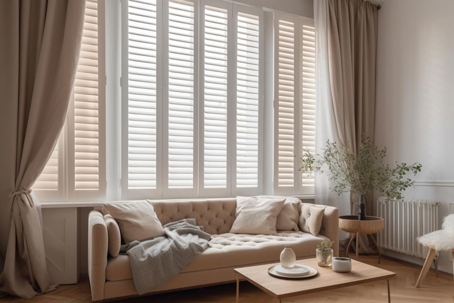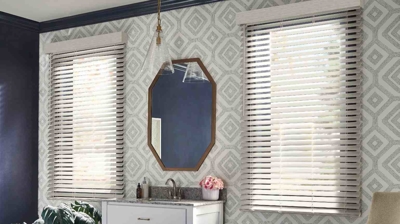Do’s and Don’ts of Pairing Blinds With Curtains
Enhance your interior design by thoughtfully pairing blinds with curtains! While the primary function of window blinds and curtains is often to regulate light and provide privacy, their strategic combination can profoundly influence the room's atmosphere.
Create an inviting and sophisticated home décor by striking the perfect balance between functionality and aesthetics, ensuring control over light, privacy, and style, while also enriching the ambiance. Explore the essential guidelines and creative tips for harmonizing drapery and blinds in the sections that follow.
Why Use Curtains and Blinds?
Mixing curtains and blinds has aesthetic and practical advantages. This favored option among interior designers offers versatility, catering to various needs. Let’s examine some of the main benefits of this window cover combination below.
Light Control
Enhance any room’s ambiance with curtains that allow soft, natural light to filter in while maintaining daytime privacy. Crafted from delicate, translucent fabrics available in various colors, styles, and weights, sheer curtains add a touch of elegance.
For moments requiring a darker room, turn to block-out roller blinds. These blinds create a cozy atmosphere during movie time and are designed to block incoming light. Combining the versatility and functionality of sheer curtains and block-out roller blinds provides considerable light control.
Temperature Control
Curtains filter sunlight, reducing its intensity and enabling temperature control and energy efficiency inside the home. During scorching weather, closing block-out roller blinds will maintain a colder room and alleviate the strain on an HVAC system. Thermal block-out roller blinds with superior insulation remain an excellent investment in preparation for hot summers.
Acoustic Insulation
Pairing heavy curtains with vertical blinds will help soundproof a room, diminishing external noise and establishing a serene indoor atmosphere. This benefit significantly improves the lifestyles of residents living near bustling roads or disruptive neighbors.
Privacy Control
Sheer curtains present a solution for maintaining privacy during the day, obstructing the view into a home. However, when privacy becomes a concern at night, combining drapes with blackout shades will prevent anyone from peering inside the house.
UV Protection
Enhance a home’s UV protection by using drapery and blinds to block sun rays. Heavy curtains are an excellent choice for maximum light filtering. They prevent the fading of furniture, flooring, and other interior elements. If paired with blackout blinds, they will completely block UV rays when fully closed.
Curtains and Blinds Unlock New Options
More options exist when decorating windows with a combination of blinds and curtains. In colder climates, use heavier curtains for insulation during winter nights. On the other hand, lighter curtains allow ample natural light to create a more lively atmosphere.
Hang curtains with blinds in bedrooms to keep the room dark for better sleep quality. Heavier curtains paired with Venetian blinds provide flexibility, providing extra control over light transmission.
Curtains complement roller blinds, honeycomb blinds, pleated blinds, wooden blinds, and faux wood blinds. For practical homeowners, aluminum mini blinds offer simplicity and flexibility. Faux wood blinds are a great alternative to wood and still achieve the same classic look.
The Do’s and Don’ts of Pairing Blinds and Curtains
Most homeowners want the ability to control privacy and sunlight. Others focus on the transformative impact of window covers. Either way, the combination of curtains and blinds will instantly enhance a home’s atmosphere. Uncover the secrets of window treatment professionals who integrate curtains and blinds to achieve the perfect ambiance.
Do Pick the Blinds First
When pairing curtains and blinds, first select the blinds that best suit the room. Roller or Venetian blinds remain popular choices, complementing most drapes and providing a solid color base. Consider color and fabric selections that harmonize with the overall room décor.
Many interior designers prefer blinds with timber or aluminum materials because they offer a natural look with warm colors that pair well with most curtains. They usually choose a muted shade as the focal color of wood blinds.
Today’s modern designers might hang curtains with a burnt orange shade for a vibrant contrast against the natural tones of the timber blinds, especially if the room features cool colors like blues and whites. For a more subtle look, white or light cream drapes will create a crisp, clean appearance that complements most blind styles.
Don’t Combine Print With Patterns
Improve the appearance of any bedroom by choosing the right combination of curtains and blinds. An interior designer may pair a solid color curtain with printed blinds for a harmonious layered look. This approach will create a balanced effect, especially in small, busy spaces.
If homeowners prefer the natural texture of wood, designers might add a solid-colored curtain for balance or patterned drapes for a traditional look. Before mixing colors and patterns, a designer will thoroughly check combinations that match the existing interior design.
Do Choose Tall, Broad Options
One of the significant advantages of combining curtains and blinds is the ability to alter your guests’ perceptions of window sizes. By pairing curtains and blinds, interior designers will create the illusion of large windows and a higher ceiling.
Installing Roman shades near the ceiling will change how spacious a room looks. Installers can hang the curtain rods 30-60 centimeters above the windows to enhance the effect. This method also allows the drapery to gently brush the floor, adding elegance to a room and maximizing its visual appeal.
Don’t Hesitate to Add Accessories
Choosing one or two accessories can add a unique flair to windows. For tiebacks, modern designers often use a simple piece of tieback fabric to achieve an elegant draped effect. Another great alternative is a discreet wall-mounted metal piece hung behind the curtains.
The decorative pieces designers are cautious with are large, ostentatious metal curtain rods or tiebacks with tassels. They may clash with the natural shades of timber. Adding pelmets over curtains is an excellent way to enhance windows, giving them a classic look and added depth.
These features will conceal curtain tracks and operational components for a seamless finish. They also offer better insulation and complete light blockage. Roman blinds with pelmets are popular due to their sleek, refined appearance.
Do Make the Room Feel Cozy
Achieving fullness with your window treatment will transform the overall look and feel of the space to make it more welcoming. Interior designers layer blinds behind curtains to accomplish this effect. Layering Roman blinds can also create a cozy and elegant atmosphere.
These blinds are available in various options, including sheer, textured, or blackout, making them an excellent choice in any situation. When paired with linen sheers, Roman blinds make an even stronger statement. For a more relaxed, simplified effect, interior designers utilize timber blinds and pair them with sheers that lack a heavy sheen or metallic threading.
Don’t Pick the Same Curtains for the Whole House
Almost all interior designers avoid using a single curtain set throughout a house. This kind of decor will create confusion between the spaces. Combining blinds and curtains helps pull one entire space together and bring about the desired atmosphere in each room.
Since the ambiance varies from room to room, interior designers choose a style that resonates with their clients. They also consider the amount of light they want to allow into each room. This method lets them experiment with different styles, such as using neutral, fitted sheers, and observe how they interact with the natural light.
Do Match the Window Covers With the Curtain Rod
Interior designers should consider the hardware when installing curtains and blinds, including the curtain rods. Before designers decide on the shades, they must ensure the rod complements the window treatments.
Interior designers usually avoid using high-shine curtain rods because they might overpower the curtains and blinds. Using hardware with a matte finish will maintain a cohesive look that enhances the selected window cover style.
Get Your Layered Window Treatments From Bumble Bee Blinds
Now that you know the benefits of combining blinds with curtains, improve your home’s interior design. Our creative window treatment experts can install the perfect blinds and curtains in any style. Call Bumble Bee Blinds at (844) 387-1716 to book a free consultation today!




